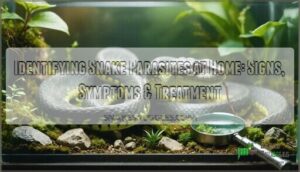This site is supported by our readers. We may earn a commission, at no cost to you, if you purchase through links.
 Identifying snake parasites at home starts with watching your pet’s daily habits and physical appearance.
Identifying snake parasites at home starts with watching your pet’s daily habits and physical appearance.
You’ll notice weight loss despite normal feeding, irregular shedding patterns, and lethargy in infected snakes.
External parasites like mites appear as tiny moving dots between scales, while internal parasites cause regurgitation, loose stools, or visible worms in feces.
Check for red, irritated skin patches and unusual scratching behaviors against enclosure surfaces.
Your snake might also show decreased appetite or complete food refusal.
Temperature preferences may change, with infected snakes seeking cooler areas.
Document these symptoms with photos and notes for your veterinarian.
Early detection makes treatment simpler and more effective, preventing serious health complications that could threaten your snake’s life, and is crucial for effective treatment and preventing threats, ensuring a better chance of recovery with proper care and early detection.
Table Of Contents
- Key Takeaways
- Snake Parasite Types
- Identifying Parasite Symptoms
- Diagnosing Snake Parasites
- Treating Snake Parasites
- Preventing Snake Parasites
- Managing Snake Mite Infestations
- Frequently Asked Questions (FAQs)
- What are the symptoms of snake parasites?
- How to identify snake mites in a house?
- How do I check if I have parasites at home?
- Does isopropyl alcohol kill snake mites?
- How often should I check my snake for parasites?
- Can parasites spread between different reptile species?
- What temperature kills parasite eggs in substrate?
- Are wild-caught snakes more prone to parasites?
- Can I use human antiparasitic medications on snakes?
- Conclusion
Key Takeaways
- Watch for external signs – You’ll see tiny black dots moving between scales (mites), red irritated patches, excessive scratching against surfaces, and your snake soaking more than usual to drown parasites.
- Monitor eating and behavior changes – Look for weight loss despite normal feeding, complete food refusal, lethargy, decreased activity, and unusual temperature preferences like seeking cooler spots.
- Check digestive symptoms for internal parasites – You’ll notice regurgitation, loose stools, visible worms in feces, and irregular shedding patterns that signal internal parasite problems.
- Document everything for your vet – Take photos of symptoms, keep notes on behavioral changes, and collect fresh fecal samples within 12 hours for accurate parasite identification and treatment.
Snake Parasite Types
You’ll encounter three main types of parasites that can affect your snake’s health.
External parasites like mites and ticks live on the skin, internal parasites such as worms inhabit the digestive system.
Microscopic protozoa can damage multiple organs throughout your pet’s body.
External Parasites
External parasites lurk on your snake’s skin like unwelcome guests at a party. These blood-sucking troublemakers include snake mites, ticks, and leeches that cause serious health problems.
These tiny blood-suckers crash your snake’s skin party uninvited.
Watch for these warning signs:
- Tiny black dots moving across your snake’s scales
- Red, irritated patches between scales showing mite infestation
- Swollen areas around eyes from tick attachment
- Crusty skin lesions from parasite feeding
- Your snake soaking excessively to drown mites
Mite identification requires careful observation, especially around the eyes and jaw where these pests prefer feeding.
Internal Parasites
Internal parasites set up shop in your snake’s digestive system, causing serious health problems you can’t ignore.
Roundworm infections create intestinal blockage while hookworm symptoms include weight loss and weakness.
These parasites follow complex lifecycles, making parasite identification tricky without fecal tests.
Digestive issues like vomiting signal trouble brewing inside, watch for poor appetite and abnormal droppings when identifying snake parasites—they’re telltale signs something’s wrong internally.
Protozoa Infections
Protozoa are microscopic troublemakers that attack your snake’s organs from within.
These single-celled parasites include flagellate diseases, amoeba infections, and ciliate parasites that cause serious organ damage.
Unlike other parasites, protozoa trigger severe immune response problems throughout multiple body systems.
A fecal test helps with parasite identification, revealing these hidden threats before they overwhelm your snake’s defenses.
Understanding snake health risks is essential for effective prevention and treatment of protozoa infections in snakes, which can lead to serious organ damage and require a strong immune response.
Identifying Parasite Symptoms
Recognizing parasite symptoms early can save your snake‘s life and prevent costly veterinary bills.
You’ll need to watch for specific physical signs and behavioral changes that signal your pet needs immediate attention.
Skin Irritation Signs
Three telltale skin irritation symptoms reveal snake parasite problems you can’t ignore.
Look for raised, red areas between scales where mites attach and feed.
Crusty patches and fluid-filled lesions signal ongoing irritation, while rough skin texture develops from persistent scratching.
Small black or gray specks moving across your snake’s skin are classic mite symptoms requiring immediate attention.
Regular checks for snake skin problems can help identify these issues early on, which is crucial for addressing skin irritation and persistent scratching.
Behavioral Changes
Watching your snake’s daily routine reveals telltale snake parasite symptoms through distinct behavioral changes.
Parasitized snakes display lethargy signs, becoming sluggish and unresponsive to normal stimuli. Activity changes include excessive hiding, reduced movement, and prolonged soaking—attempts to drown irritating mites.
Stress factors from parasites trigger social withdrawal, making typically curious snakes retreat constantly. These behavioral symptoms often appear before visible signs, making observation essential for early detection.
Recognizing parasite infection signs is critical for identifying the underlying cause of these changes, which can lead to early detection and proper treatment to address the parasite infection.
Appetite Loss Indicators
When you’re dealing with snake parasite symptoms, appetite changes often serve as your first red flag.
Your snake’s feeding response tells the whole story about their internal health.
- Weight Loss Signs – Visible spine or hip bones protruding
- Poor Feeding – Refusing favorite foods or treats consistently
- Food Avoidance – Turning away from prey items completely
- Nutrition Deficits – Becoming lethargic after missed meals
- Irregular Patterns – Skipping multiple feeding sessions unexpectedly
Diagnosing Snake Parasites
Once you spot the warning signs, you’ll need to confirm what type of parasite is bothering your snake through proper diagnostic methods.
A thorough examination combines checking your snake’s medical history, testing fecal samples, and sometimes using imaging techniques to get the full picture.
Medical History Importance
When documenting your snake’s medical history, track feeding schedules, weight changes, and behavioral shifts you’ve noticed.
These health checks provide your vet with valuable insights during vet consults.
Disease patterns emerge when you record symptoms over time, helping create effective treatment plans for diagnosing snake parasites and maintaining ideal reptile health.
Fecal Sample Examination
Fecal testing reveals the hidden world of parasites living inside your snake. Fresh stool samples give you the clearest picture of what’s happening in your pet’s digestive system.
Laboratory testing uses microscopic examination to spot parasite eggs, larvae, and protozoa that you can’t see with your naked eye.
- Fresh sample collection: Gather feces within 12 hours using disposable gloves and sealed containers for accurate parasite detection
- Microscopic protozoa identification: Direct saline wet mounts reveal moving organisms while staining techniques highlight hard-to-spot parasites
- Multiple testing rounds: Single negative results don’t rule out infection since parasites shed intermittently, requiring repeated stool analysis
Radiology Techniques
When traditional fecal testing comes up short, your veterinarian might recommend advanced imaging techniques to get a clearer picture.
X-ray imaging can reveal internal parasites lodged in organs, while ultrasound shows real-time movement of worms.
CT scans and MRI tests provide detailed cross-sections of your snake’s body, helping pinpoint exact locations of stubborn parasites that hide from standard laboratory testing methods.
Effective snake parasite treatment requires understanding of parasite control methods to prevent reinfection and promote overall snake health.
Treating Snake Parasites
Once you’ve diagnosed parasites in your snake, effective treatment becomes your top priority to restore your pet’s health.
The good news is that most snake parasites respond well to targeted medications when you work with a reptile veterinarian to choose the right approach.
Deworming Medications
Several deworming medications effectively target different parasites in your snake.
Your vet will select the right medication based on which parasites they’ve identified through testing. Regular parasite control measures are essential for maintaining your snake’s health.
- Fenbendazole – Works against roundworms and most intestinal parasites with excellent safety
- Ivermectin – Targets mites and nematodes but toxic to some colubrids
- Praziquantel – Best snake dewormer for tapeworms and flukes
- Levamisole – Effective for lungworms through injection
Fenbendazole Usage
You’ll administer fenbendazole orally at 25-50 mg/kg body weight for effective snake parasite treatment.
This deworming medication targets roundworms and hookworms when given every 7-14 days.
Always weigh your snake first – accurate fenbendazole dosage prevents toxicity while ensuring successful parasite control.
Follow your vet’s deworming schedule precisely for maximum medication safety.
For proper administration, understanding the correct Fenbendazole dosage is essential to avoid overdose.
Ivermectin Treatment
When treating snake parasites, Ivermectin works like a targeted missile against external pests.
Ivermectin strikes fast—a precision weapon in your parasite-fighting arsenal.
This medication effectively eliminates mites and ticks that plague your reptile.
Follow dosing guidelines carefully—typically one drop per snake based on weight.
Treatment duration spans two weeks with repeated applications.
Monitor for medication side effects like lethargy during snake recovery, ensuring proper deworming success.
Preventing Snake Parasites
You can prevent most snake parasites by keeping your pet’s environment spotless and quarantining new arrivals.
Simple hygiene habits like washing your hands after handling and monthly deep cleaning with bleach solution will stop parasites before they become a problem, following simple habits consistently.
Hygiene Practices
Clean hands thoroughly before and after handling your snake to prevent spreading parasites between animals.
Regular hand washing with soap breaks the transmission cycle effectively. Maintain your snake enclosure with weekly deep cleaning using appropriate cleaning products and sanitation methods.
Daily spot cleaning removes waste that attracts parasites. Proper hygiene routines protect your snake’s health and prevent mite symptoms from developing into serious infestations requiring intensive mite treatment.
Your snake’s health is crucial, and proper hygiene is key to preventing the spread of parasites. Regular hand washing is essential in this process.
Quarantine Procedures
Before bringing new snakes home, you’ll want to set up proper quarantine procedures to protect your existing reptiles.
Isolation methods require a separate room or dedicated quarantine space for 2-3 months minimum.
Sanitation protocols include washing hands between handling different animals and using separate cleaning tools.
Biosecurity measures prevent cross-contamination through dedicated equipment for quarantined snakes.
These snake parasite prevention steps create a safety buffer that’s worth every day of waiting.
Managing Snake Mite Infestations
Snake mites can turn your pet’s enclosure into a nightmare faster than you’d expect.
You’ll need to act quickly with the right identification skills, treatment products, and thorough cleaning methods to eliminate these persistent parasites.
Mite Identification Methods
How can you spot these tiny bloodsuckers before they multiply? Mite inspection requires sharp eyes and proper snake examination techniques for accurate infestation detection.
- Visual check: Look for moving black, red, or gray specks around eyes, nostrils, and jaw areas
- White paper test: Handle your snake over white paper to catch falling mites
- Water bowl monitoring: Check for floating black specks indicating mite reproduction
- Magnifying glass exam: Inspect skin folds and mite hiding places under scales closely
Treatment Spray Solutions
For battling those pesky mites, you’ve got three main spray solutions in your arsenal.
Natural sprays offer gentle relief, while Ivermectin solutions pack more punch for stubborn infestations.
Fipronil products deliver the heavy artillery when mites refuse to surrender.
Choose your mite remedy based on infestation severity, then follow snake mite treatment steps carefully for effective results.
Effective mite control often involves understanding mite treatment options to select the best approach, including natural sprays and using the right treatment for the infestation severity.
Enclosure Cleaning Procedures
After selecting your treatment spray, you’ll need to tackle enclosure sanitization.
Remove your snake to a temporary, mite-free space first.
Discard substrate and porous items that can’t be properly cleaned.
Soak all decorations and accessories in 3% bleach solution heated to 122°F.
Apply your chosen mite spray following manufacturer instructions for snake mite spray application.
Regular cleaning helps maintain proper snake enclosure cleanliness to prevent parasite infestations.
Frequently Asked Questions (FAQs)
What are the symptoms of snake parasites?
Snake parasites show several telltale signs you’ll want to watch for.
Look for poor appetite, weight loss, vomiting, abnormal stools, skin irritation, and small black dots moving on your snake’s skin or scales.
How to identify snake mites in a house?
Look for tiny black, gray, or red specks moving on surfaces, especially around warm areas like heating vents.
Check for ash-colored dust on dark surfaces and inspect water bowls for floating black dots.
How do I check if I have parasites at home?
Check your body for unexplained symptoms like fatigue, digestive issues, skin problems, or weight changes. Consider stool testing through your doctor or home test kits for intestinal parasites.
Does isopropyl alcohol kill snake mites?
Yes, isopropyl alcohol can kill snake mites on contact, but it’s not recommended as a primary treatment.
It may irritate your snake’s skin and doesn’t provide lasting protection against reinfestation like specialized mite treatments do.
How often should I check my snake for parasites?
Examine your snake weekly during routine handling sessions, checking for external signs like mites or skin irritation.
Additionally, monitor fecal samples monthly for internal parasites, watching for unusual consistency or visible worms throughout regular care, which can help identify parasites.
Can parasites spread between different reptile species?
Parasites absolutely spread between different reptile species.
Snake mites, ticks, and internal worms don’t discriminate—they’ll happily jump from your snake to your gecko or bearded dragon.
Always quarantine new reptiles separately.
What temperature kills parasite eggs in substrate?
Fascinating fact: All life stages are apparently killed by exposure to temperatures in excess of 105°F (38°C) , including parasite eggs.
Heat your substrate in the oven to 122°F or microwave for five minutes to eliminate mites and ensure that all stages, including eggs, are killed by the heat treatment.
Are wild-caught snakes more prone to parasites?
Wild-caught snakes typically carry more parasites than captive-bred ones since they’ve been exposed to various pathogens in nature. You’ll find they often need immediate veterinary screening and treatment upon acquisition.
Can I use human antiparasitic medications on snakes?
Don’t play doctor with your scaly friend’s health! Human medications can be dangerous for snakes. You’ll need reptile-specific treatments from a veterinarian who specializes in these unique creatures.
Conclusion
Sarah noticed her ball python scratching constantly against decorations and refusing meals for two weeks.
After finding tiny black specks moving between scales, she realized mites had infested her snake’s enclosure.
Identifying snake parasites at home requires vigilance and quick action.
You’ll spot external parasites through visual inspection and behavioral changes.
Internal parasites show through appetite loss and digestive issues.
Document symptoms immediately and consult your veterinarian for proper diagnosis and treatment protocols to guarantee your snake’s health.
- https://www.petmd.com/reptile/conditions/skin/c_rp_external_parasites
- https://www.merckvetmanual.com/all-other-pets/reptiles/disorders-and-diseases-of-reptiles
- https://www.wisconsinherps.org/educational-articles/acariasis-dealing-with-the-dreaded-snake-mites
- https://www.petful.com/pet-health/snake-skin-problems/
- https://pmc.ncbi.nlm.nih.gov/articles/PMC4345101/















